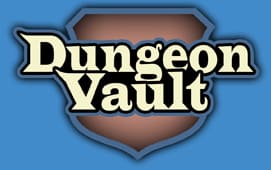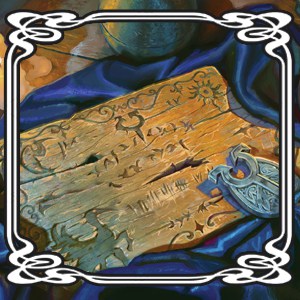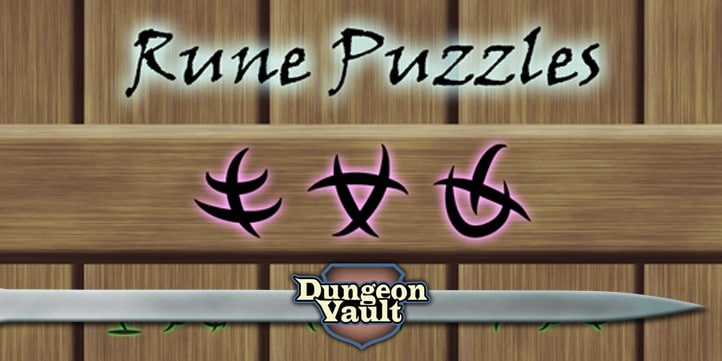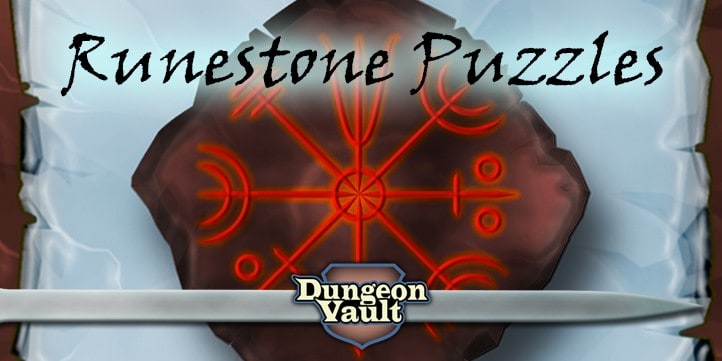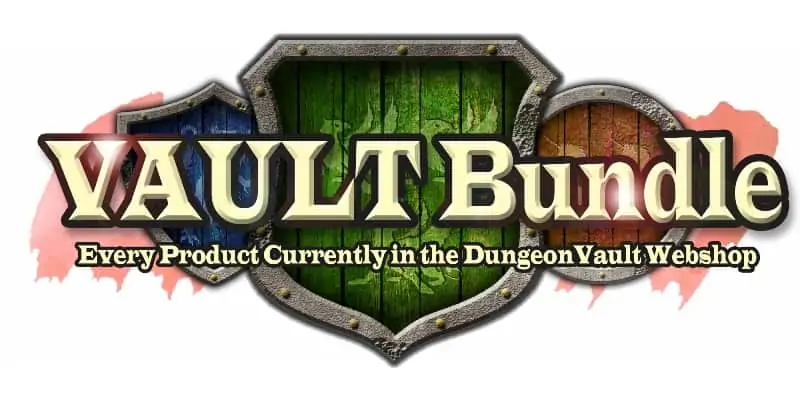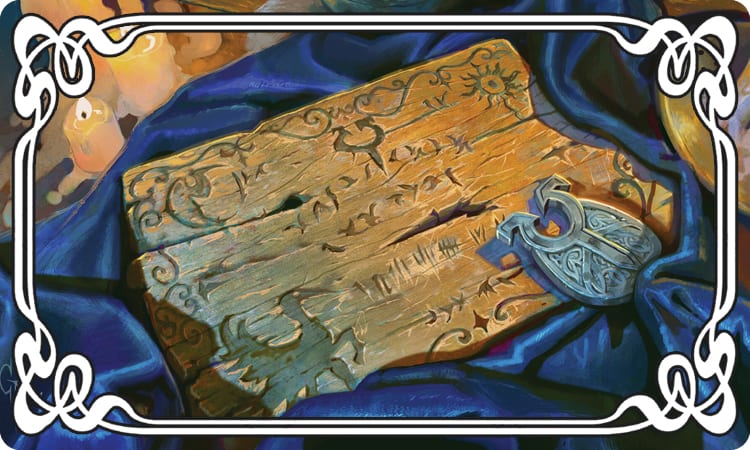
Puzzles involving a cipher or code have many benefits for use in your Dungeons & Dragons game. They are very quick to create for one thing. And with the method I’ll show you in this article, you can create a cipher puzzle in under five minutes. Cipher and code puzzles also tie to the story very easily, because whatever message they reveal can be a vital clue to continuing the story. There are also pitfalls to using ciphers and we’ll discuss how to avoid those as well.
So here’s a list of quick and easy cipher and code puzzles to use!
Colour Cipher Puzzles
A colour cipher can also be set up in under five minutes. Knowing which colours are relevant and which to ignore is key to solving this puzzle.
Step 1:
Write a short message and pick three colours. For instance, the message is ‘the well is poisoned’ and the colours are blue, green, and orange.
THE WELL IS POISONED
Step 2:
Remove all spaces and randomly assign the three colours to the characters.

Step 3:
Add random characters of different colours.

You can add as many colours a random characters as you like. With this puzzle only provide the three correct colours as clues.
Anagram Cipher Puzzles
An anagram cipher puzzle simply involves rearranging the characters of the words in a short sentence. You can adjust the difficulty by highlighting the first letter in each word if you want to. Be aware that this becomes increasingly hard to solve if you use a longer message.
Step 1:
Write out a short message.
THE WELL IS POISONED
Step 2:
Rearrange the characters randomly. Use an online anagram maker and pick a anagram that sounds like if could mean something.
LILITHS WOOS DEEPEN
Step 3:
Give some clue that this might be an anagram if players don’t solve it by themselves.
Caesar Cipher Puzzles
A Caesar cipher puzzle uses the alphabet and shifts the characters by a number of steps.
Step 1:
Write out a message.
THE WELL IS POISONED
Step 2:
Use an online Ceasar cipher maker to encode the message and choose by how many steps you wish to shift the characters.
UIF XFMM JT QPJTPOFE
Step 3:
Allow players to find the algorithm so they can start solving the cipher.
Substitution Cipher Puzzles
A substitution cipher puzzle and a code puzzle are really the same thing. Here’s why:
- A code puzzle substitutes arbitrary symbols which are typically letters or numbers.
- A cipher puzzle uses an algorithm to transform a message into an apparently random string of characters.
However, with a substitution cipher puzzles the algorithm IS substituting characters. So call it a code or a cipher if you wish. I don’t care so long as we can put it on the table in under five minutes.
Step 1:
Open word and write your message. Keep it short and sweet because substitution ciphers become easier to solve as they get longer.
THE WELL IS POISONED
Step 2:
Go to a website where you can download a free rune or code font. Here are some suggestions.
Select the message in word, change the font to your symbols and press print.

Step 3:
Give players the clues to each character.
Introducing Cipher and Code Puzzles
That takes care of encoded your messages, but in order to make it work for your players you also need to consider four things:
- Having players cooperate in solving the cipher puzzle: Divide the clues.
- Introducing the clues: Complicate their lives.
- Creating an exciting outcome: Relevant stakes.
- Using artwork: Immerse the players in the world
Paying attention to these elements will make or break your puzzle and allow you to avoid common pitfalls. When setting up your puzzle it helps to work backwards. So we’ll start with the outcome: What will happen if players solve the cipher puzzle?
There are many options. For instance, if players find the substitution cipher puzzle on the body of a slain enemy, it could be an important piece if information that can turn the tide of a battle. That’s an exciting outcome with relevant stakes, and figuring out the message becomes a race against time while the enemy is gaining ground. To introduce the clues you could place them in a library that is about to be overrun or already in enemy territory. In short, with every step of building the context of the puzzle, you want to complicate matters for the players. To have players work together have each of them find only a couple of letters which they must share to decode the entire substitution cipher. Finally, you want to use artwork. A printed sheet of clean white paper doesn’t scream Dungeons & Dragons. So change your printed sheet into a piece of parchment, photoshop until you drop, but for Pelor’s sake do something to immerse the players into your world!
You could also place the cipher puzzle on a locked chest deep in a dungeon. Here the stakes are finding out what treasure is inside. You can introduce the clues to the code by spreading them out around the dungeon. This complicates their lives because they now have to clear the whole dungeon. Another option would be to have players roll int checks to see if they can solve on character. This challenges the pcs and not the players, but it also divides the clues forcing cooperation.
In my experience, nailing these elements is more important than the puzzle itself. And in complicating their lives you add an element that allows players to use their pcs’ powers, which makes puzzles much more enjoyable for everyone.
Layering Cipher Puzzles
While this type of puzzle is fun and easy, for the players, if gets old fast. You might be tempted to look for more complicated ciphers to keep thing interesting, but most advanced ciphers are very complicated. The result is that one player will hog the cipher puzzle and the other players will wait for the challenge to be over.
Instead, I recommend only using the easy cipher puzzles mentioned before and layering them. By layering puzzles one solution leads to the next puzzle. For instance, players could solve a colour cipher puzzle that opens a chest. Inside they find an anagram cipher puzzle and so on. This way players will solve a number of easy puzzles in quick succession. The benefit of this method is that they will experience more successes, there is a journey of discovery, and they will still feel like they have met a great challenge together, even though the individual steps weren’t that difficult.
Of course a real puzzle desinger’s challenge would be to layer multiple types of cipher puzzles within a single line of text. That’s what I’ve done with Rune puzzles.
Rune puzzles are a type of cipher puzzle where players find a single line of runes. You can place these rune onto any object to lock it or secure it’s magical powers. So you could drop this on a chest and lock it, but you can also drop it on a magical sword that only unleashed it’s powers once the rune puzzle is solved.
The great thing about rune puzzles is that, even though it is only one image, there are three layered ciphers to uncover. The first step is obviously a substitution cipher. Players must exchanges the runes for characters. The other two steps I’ll keep hidden for now because I don’t want players finding the answer online.
You can layer your ciphers yourself, but if would take about 20 minutes to create a single layered puzzles and that is without creating the artwork. This pack contains 30 puzzles with all the work done for you in tabletop and virtual tabletop format.
Using ciphers isn’t the only way to introduce runes as puzzles. With runestone puzzles players must match rune symbols on runestones. The benefits are that the puzzle can be viewed from all sides of the table, and you can create an infinite amount of puzzles with this system. And who doesn’t like finding runestones?

Also, artwork makes a lot of difference in how players experience a puzzle. There aren’t that many great ways to add physical objects for your players to play around with in D&D other than terrain, mini’s, and dice. This is where puzzle pieces can really help create a unique gaming experience.
The Vault Bundle
If you want to see my complete collection or illustrated puzzles, check out the vault bundle. It contains hundreds of puzzles and much more to surprise your players with something they’ve never seen before every time.
